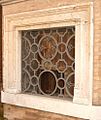Baby hatch facts for kids
A baby hatch (sometimes called a foundling wheel) is a safe place where parents can leave a newborn baby if they are unable to care for it. This system allows parents to give their baby up for adoption without anyone knowing who they are. Baby hatches have been used for a very long time, even since the Middle Ages.
These hatches are usually found at hospitals, social centers, or churches. They are often a small door or flap in an outside wall. When opened, it reveals a soft, warm bed inside. Special sensors in the bed let staff know when a baby has been placed there. This means the baby can be quickly taken care of by hospital staff. If no one claims the baby after a certain time, it will be placed for adoption. Baby hatches are still used today in countries like Germany and Pakistan. They offer a safe option for parents who are in a difficult situation and need help for their child.
The History of Baby Hatches
Baby hatches first appeared a very long time ago, in medieval times. The first known baby hatch was set up in Italy in the year 1198. They became more common after the 1600s. However, by the 1800s, they started to be used less often.
Today, only some countries have baby hatches. In other places, they are not allowed by law.
Other Pages to Explore
Images for kids
-
A baby hatch in Germany
-
A baby hatch called "BabyBox" in the Czech Republic
-
A baby hatch in Poland. The words OKNO ŻYCIA mean "Window of Life"
-
A foundling wheel at the "Ospedale di Santo Spirito" in Rome
-
A foundling wheel at the "Ospedale degli Innocenti" in Florence
-
The Foundling Hospital in London
-
A baby hatch in Rabat, Malta
-
A baby hatch in Ludwigshafen, Germany
-
A baby hatch in Warsaw, Poland, in 2018












